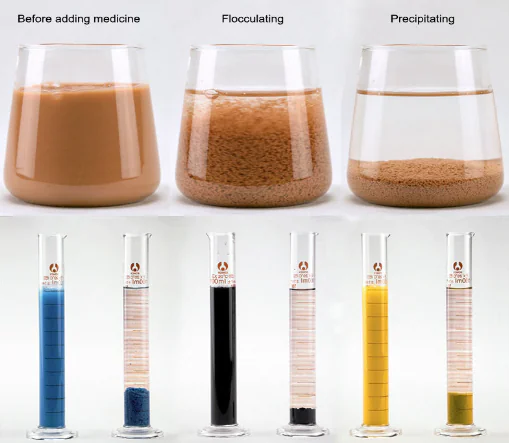When discussing the properties of polyacrylamide (PAM), the degree of hydrolysis is very important. It affects PAM’s flocculation performance, solubility, and stability. It also determines its use in different water treatment processes. Today, we will explore how PAM’s hydrolysis affects its performance and learn how to control it for better applications.

What Is the Degree of Hydrolysis of PAM?
The degree of hydrolysis (DH) shows how much of the acrylamide (AM) monomers in PAM have reacted with water. During hydrolysis, the amide groups (–CONH₂) break and form carboxylate groups (–COO⁻) and amine groups (–NH₃⁺) as follows:
–CONH₂ + NaOH → –COONa + NH₃↑
👉 The hydrolysis degree is expressed as a percentage, showing how many AM units are hydrolyzed.
- Hydrolysis Percentage: The percentage of acrylamide units that have been converted.
- Hydrolysis Rate: The amount of hydrolysis per unit time, which depends on temperature and pH.
How Does the Degree of Hydrolysis Affect PAM Properties?
- Flocculation Performance
🔹 A higher hydrolysis degree increases the number of charged groups in PAM, which enhances electrostatic attraction and flocculation.
🔹 Too high a hydrolysis degree may cause adverse reactions with some contaminants.
🔹 The best hydrolysis range is usually between 20% and 40%, offering good flocculation and particle adsorption.
- Solubility and Stability
🔹 Low-hydrolysis PAM (below 20%) dissolves well and suits neutral or slightly acidic water.
🔹 High-hydrolysis PAM (above 40%) is more stable in high pH. However, it can degrade in acidic conditions.
- Suitable Water Quality Environments
✅ Low-hydrolysis PAM is used for low-turbidity, weakly acidic wastewater (e.g., food processing, papermaking).
✅ High-hydrolysis PAM works better for alkaline and high-turbidity wastewater (e.g., mining wastewater, industrial wastewater).
- Other Characteristics
✅ High-hydrolysis PAM has strong adsorption capacity but takes longer to dissolve.
✅ Low-hydrolysis PAM dissolves more easily but may be less effective in very turbid water.

Factors That Influence PAM Hydrolysis
- pHValue
✅ An alkaline environment (pH > 8) promotes PAM hydrolysis and increases carboxylate groups.
✅ Acidic conditions (pH < 6) slow the hydrolysis reaction, keeping PAM at a lower degree of hydrolysis.
- Temperature
✅ High temperatures (>50°C) speed up hydrolysis and may break polymer chains, affecting stability.
✅ Low temperatures (<10°C) slow down the hydrolysis rate and may reduce flocculation efficiency.
- Polymer Structure
✅ The molecular weight, branching, and crosslinking of PAM all affect how its hydrolysis can be controlled.
- Synthesis Process
✅ By controlling the type of catalyst, reaction time, and pH adjustments, different hydrolysis degrees of PAM can be produced to meet various needs.

How to Control PAM Hydrolysis
📌 Methods to Control Hydrolysis:
✔ Adjust pH: Add bases (NaOH, Na₂CO₃) or acids (HCl, H₂SO₄) to control the degree of hydrolysis.
✔ Control Temperature: Avoid high temperatures to prevent over-hydrolysis.
✔ Optimize Dissolution Process: Use proper stirring speeds to avoid breaking the polymer chains.
✔ Choose the Right PAM: Select a low- or high-hydrolysis PAM product based on your water quality needs.
Conclusion: Hydrolysis Determines PAM’s Performance
🔹 The degree of hydrolysis affects PAM’s flocculation, solubility, and stability. Choosing a PAM product with the right hydrolysis degree is essential.
🔹 Low-hydrolysis PAM works best in acidic or neutral water, while high-hydrolysis PAM suits alkaline wastewater.
🔹 Temperature, pH, and the synthesis process all impact hydrolysis. By controlling these factors, users can optimize PAM’s performance.
📌 Stay tuned for more water treatment chemical insights! If you have any questions about using PAM, feel free to leave a comment.🚀
